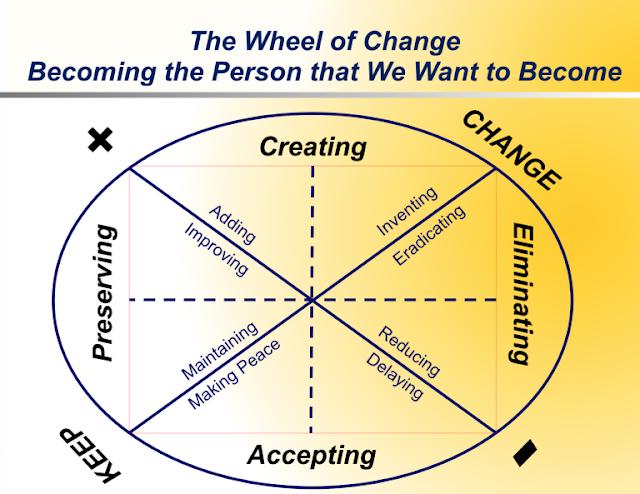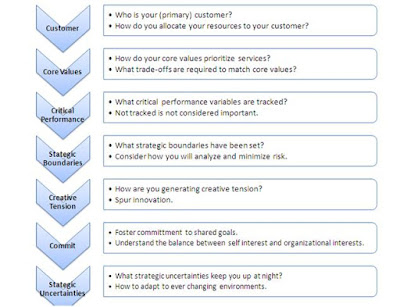One problem I have with team building assessments is that most of the data gathering and evaluation questions are very passive. It seems as if team building is something that happens to people. As opposed to people being active players in their work life.
Working with a Managing Partner in a law firm he shared his frustration like this, “We work hard to make this place somewhere people can do their best work, and be happy. And, I keep getting shit from my board about my employee engagement feedback. Many of the questions are not appropriate to lawyers. The question “I have a best friend at work” these are lawyers and they score low because they do not have time and many do not want best friends at work… Where is the way to determine their effort to be friendly, set goals, be motivated?”
I thought that was a good question and I went to work on looking for an active process of team coaching and consulting. That brought me to Marshall Goldsmith’s Wheel of Change.
The useful thing about the wheel of change is that you can accept the organizational system you are a part of, the passive stuff that you cannot control; while making an active choice to make a change, the active stuff that you can control.
“When we bluntly challenge ourselves to figure out what we can change and what we can’t, what to lose and what to keep, we often surprise ourselves with the bold simplicity of our answers and can thus take significant, real steps towards becoming the person we want to be.” – Marshall Goldsmith
Sharing the wheel of change model, following a 360-Leadership Feedback, with a team or individual you can quickly identify:
- … a behavior I choose to create or add is _____
- … a behavior I choose to preserve or enhance is _____
- … a behavior I choose to eliminate is _____
- … a behavior I choose to accept is_____
Working with many teams and individuals, we quickly saw that this concept as useful.
Using the Wheel of Change with a Team
Facilitating this with a team is similar to working with one person who is receiving leadership coaching.
- Share the wheel of change
- Explain – Create, Preserve, Eliminate, Accept
- Ask the team to share ideas for each area. I recommend you start with Create, then go through Preserve, Eliminate, Accept
- Ask the team to review each response in the wheel of change and ensure that each statement has personal accountability that is within their control, and they have the authority to act upon.
- Translate each statement into “Did I do my best to …” See below for examples.
- At the end of every day have each team member score their effort on each statement from 1 = low effort to 10 = high effort
- Repeat #6 every day for 18 months …
Example of Personal Accountability to change within a team questions
- Did I do my best to follow the billing & project process?
- Did I do my best to hold others accountable for following the billing & project process?
- Did I do my best to set project deadlines?
- Did I do my best to achieve project deadlines?
- Did I do my best to hold myself accountable to work deadlines?
- Did I do my best to see ‘our company’ as a thriving company?
- Did I do my best to preserve my quality of work?
- Did I do my best to be innovative?
- Did I do my best to achieve & uphold quality standards?
- Did I do my best to preserve a high trust, empowering office environment?
- Did I do my best to support my teammates?
- Did I do my best to accept that others hold me accountable?
- Did I do my best to accept that others have different quality standards?
- Did I do my best to accept that others have different goals & priorities?
- Did I do my best to see conflict/ resolution as a point of progress?
- Did I do my best to accept others feedback/ critique of my work?
- Did I do my best to eliminate the belief that others feedback + challenges are all about me?
- Did I do my best to eliminate ‘our company’ being a scrappy, struggling company?
- Did I do my best to stop trying to be everything to everyone?
https://bit.ly/2UR85sH
The Secret to Becoming the Person You Want to Be
by Marshall Goldsmith
For many of us, change is impossible because we are so optimistic (and delusional) that we try to change everything at once. We quickly overwhelm ourselves with becoming the “new Me”, and when it doesn’t happen as quickly as we’d like, people don’t notice that we’ve made a change, or some obstacle presents itself, we give up.
Discouraged by our failure, overwhelmed and disheartened, it’s hard to commit to change again. So, we become geniuses at coming up with reasons to avoid change. We make excuses. We rationalize. We harbor beliefs that trigger all manner of denial and resistance—and we end up changing nothing. Ever. We fail to become the person we want to be.
So, seeing our frailties in the face of behavioral change what do we do?
THE WHEEL OF CHANGE
For many years now, I’ve been using “The Wheel of Change” to help clients decide what to change and where to put their efforts. I’ve taken teams, organizations, friends, and peers through this process, and I’ve even use it myself. It is one of the most helpful tools for behavioral change that I’ve ever found.
The Wheel of Change illustrates the interchange of two dimensions that we need to sort out before we can become the person we want to be.
The positive to negative axis tracks the elements that either help us or hold us back. The change to keep axis tracks the elements that we determine to change or keep in the future. Thus, in pursuing any behavioral change we have four options: change or keep the positive elements, change or keep the negative.
Here’s a brief description of each of these options.
1. Creating represents the positive elements that we want to create in our future. Creating is the glamorous poster child of behavioral change. When we imagine ourselves behaving better, we think of it as an exciting process of self-invention. We’re creating a “new me.” It’s appealing and seductive. We can be anyone we choose to be. The challenge is to do it by choice, not as a bystander. Are we creating ourselves, or wasting the opportunity and being created by external forces instead?
2. Preserving represents the positive elements that we want to keep in the future. Preserving sounds passive and mundane, but it’s a real choice. It requires soul-searching to figure out what serves us well, and discipline to refrain from abandoning it for something new and shiny and not necessarily better. We don’t practice preserving enough.
3. Eliminating represents the negative elements that we want to eliminate in the future. Eliminating is our most liberating, therapeutic action—but we make it reluctantly. Like cleaning out an attic or garage, we never know if we’ll regret jettisoning a part of us. Maybe we’ll need it in the future. Maybe it’s the secret of our success. Maybe we like it too much.
4. Accepting represents the negative elements that we need to accept in the future. Most of us tend to commit to the other three four elements in the wheel of change with greater enthusiasm—creating is innovating and exciting, preserving makes sense as we focus on not losing sight of the good things about ourselves, eliminating appeals to the “do-or-die” element of our natures as we commit to stop doing things that no longer serve us, but accepting is a more difficult pill to swallow. Acceptance is an odd player in the process of change—it feels like admitting defeat, it’s equated by many to acquiescence. Acceptance is incredibly valuable when we are powerless to make a difference. Yet our ineffectuality is precisely the condition that we are most loath to accept. This truth triggers our finest moments of counterproductive behavior.
These are the choices. Some are more dynamic, glamorous, and fun than others, but they’re equal in importance. And three of them are more labor-intensive than we imagine.
And, that’s the simple beauty of the wheel. When we bluntly challenge ourselves to figure out what we can change and what we can’t, what to lose and what to keep, we often surprise ourselves with the bold simplicity of our answers and can thus take significant, real steps towards becoming the person we really want to be.





